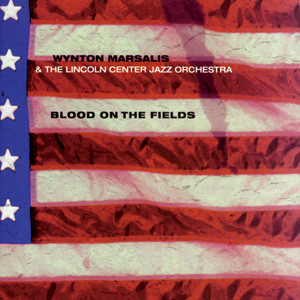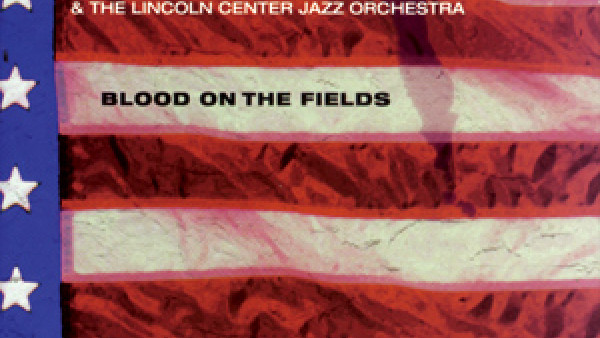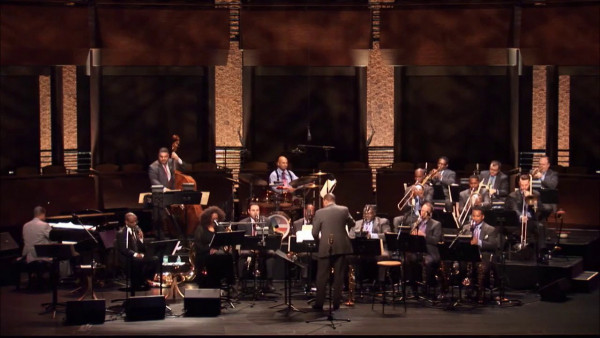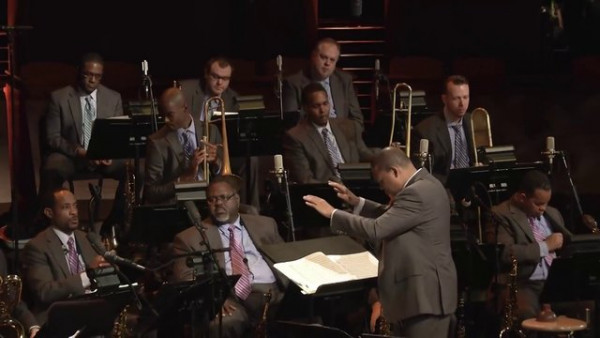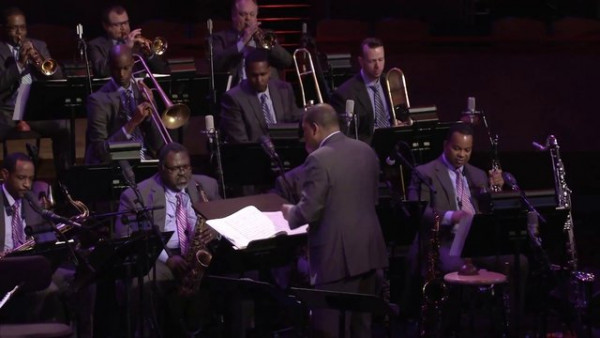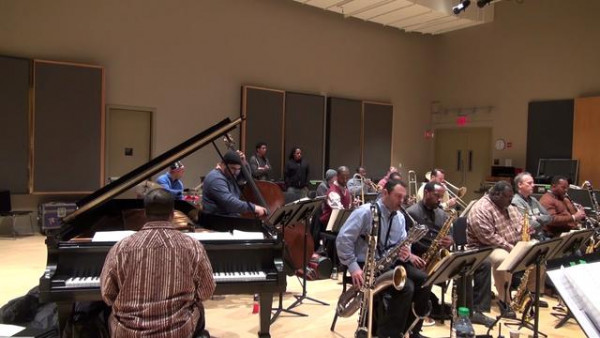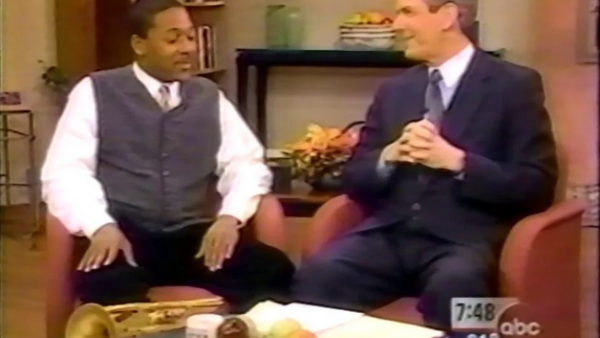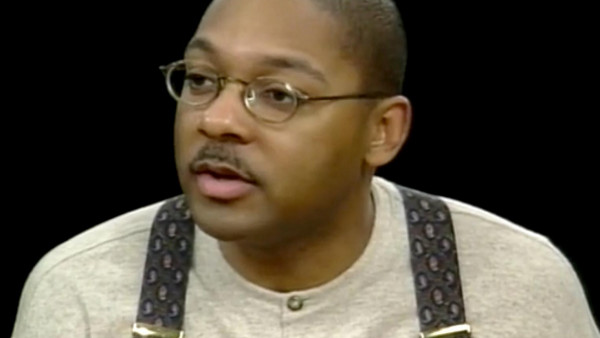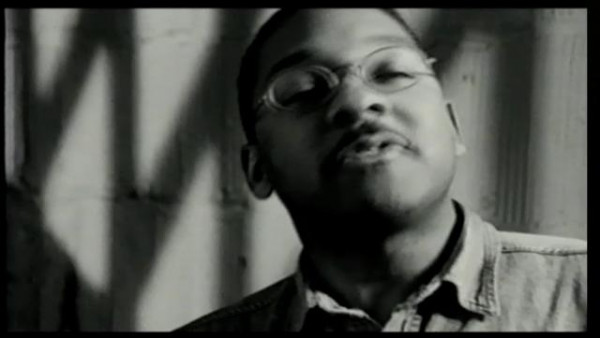Stop Nitpicking a Genius
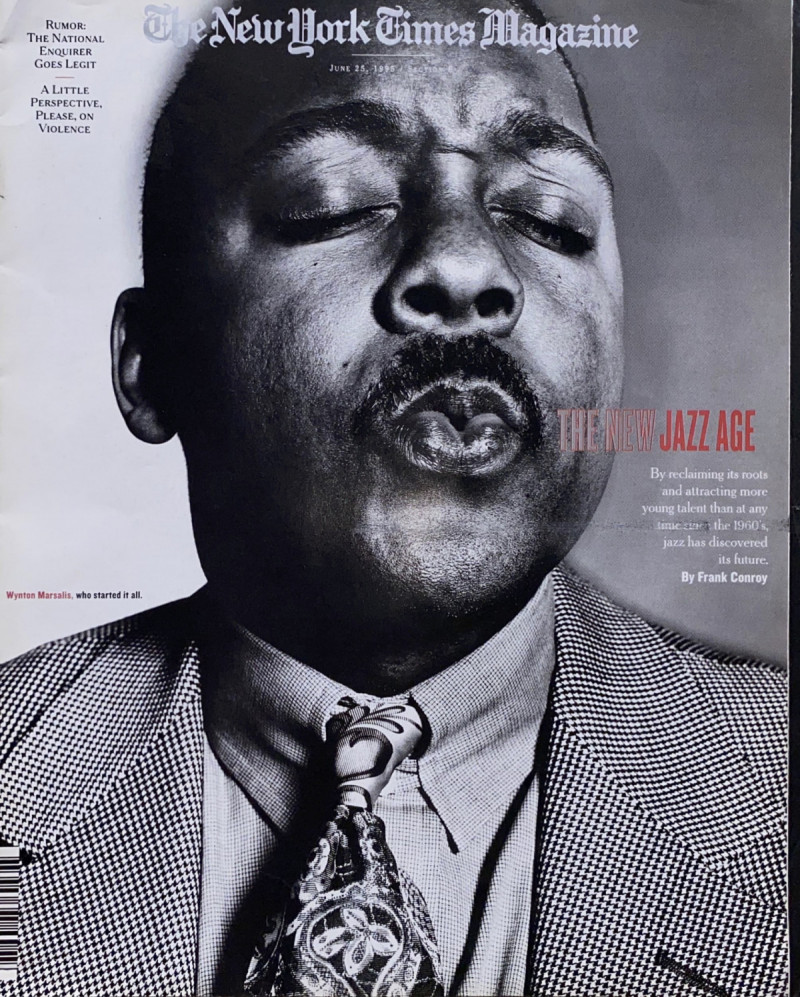
The New York Times Magazine (June 1995)
The Studio, Part I
IN THE OLD MASONIC HALL BEING USED AS A RECORDING STUDIO, WYNTON Marsalis tells the band to take a 10-minute break, steps down from the podium, comes over and gives me a hug. We sit down in the old theater seats.
“Man,” he says, “I am tired of all this stuff they’re writing about me. It has nothing to do with music.”
“The dogs bark, but the caravan rolls on,” I quote.
He laughs. “Hey, that’s good. I’ll have to remember that.”
I had read various sniping reports in the media. That he was an archivist, insufficiently avant-garde. That he didn’t hire enough white players or play enough music written by whites. That he was provincial. That he was insufficiently sensitive to multiculturalism (translation: not part of the current fad of “world music,” whatever that is). Low-level cavils from the right and from the left, which had saddened me, since he is a musical genius, the leader of a powerful renaissance in jazz and a tireless educator of the young. Personally, he is charismatic, a lover of argument, a firm, not to say tenacious, defender of his opinions about music, politics, philosophy and everything else, very bright and mildly impatient — all of which rubs some people the wrong way.
As both an artist and an observer of the musical scene, Marsalis is drawn to clarity. He abhors confusion. Unfortunately, a good deal of confusion continues to exist in the jazz world, partly because the old order is giving way to the new and partly because of the history of obscurantism, defensiveness and hermeticism that has prevailed for something like 50 years.
Jazz is a fine art, and the only fine art to have been developed from scratch in America, where recognition, paradoxically, has been slow in coming — perhaps because the music emerged from black culture, from the bottom (economically speaking) up. Some protectiveness and secrecy on the part of the musicians was perhaps to be expected. Many black musicians were covetous, and some grew angry through the years as they saw white players making more money than themselves playing jazz or watered-down jazz. (It used to be said that jazz players were either black, Jewish, Italian or Irish — very close to the truth — and it was the blacks getting the short end of the stick from the union, the recording studios and the bookers.)
As well, jazz had an ominous side. Most players were honest, hard-working men, often subsidizing their music with ordinary jobs, known as “day gigs,” but there were also drug addicts and dealers, thieves and pimps. A number of very famous players in the 1940’s and 1950’s ran strings of prostitutes to augment their incomes. Thus, there were people creating sublimely beautiful music while living sublimely ugly lives (strengthening the vulgar and false idea that the authenticity of the music was a function of the degree of misery in the life of the player). Public perception of jazz has been heavily tainted with notions of criminality and degeneracy, and lingers still, albeit faintly, despite the fact that conditions have changed completely.
There are jazz programs in virtually all the colleges and universities. Jazz clubs around the country are “high class” and expensive. Institutional efforts like Jazz at Lincoln Center (of which Marsalis is the artistic director, thus drawing heat from people who would like a different kind of programming) are springing up around the country. The new generation of players are, by and large, educated, cultured people in their 20’s more likely to be vegetarians than drug addicts, more likely to run three miles a day than smoke cigarettes and more likely to be carrying an organ-donor card than a gun. There is a French expression, nostalgie de la boue, which means nostalgia for the gutter, and it is perhaps that preoccupation slowing down so many jazz fans, observers and writers from recognizing reality.
Jazz is American. It belongs to everybody now, black, white, Latin, to all those who have added to it and all those who have been moved by it. Fresh breezes are invigorating the music, which in turn promises to once again invigorate American culture itself. (And at this point, American culture needs all the good stuff it can get.) Heretofore, composers working from a European tradition have dipped in for a bit of spice and energy — Ives, Copland, Gershwin and others who used jazzy effects — but I believe the current renaissance will lead to a time when jazz is no longer marginalized, when artists working in jazz traditions will create work as strong as, and perhaps stronger than, those working from European traditions.
For a long time, jazz fans and players have been obsessed with the idea of “progress.” Because of the speed and abruptness of the be-bop revolution, people were looking for something quick, and what they got, mostly, were garden paths leading to no place in particular. Progress is a dubious concept in any art — have we had progress in poetry, in the novel, in painting or in dance? I don’t think so.
The idea is inappropriately linear, less useful than the model of a kind of pulsating spiral, moving out, moving in, but over time growing larger, covering more territory. Jazz is at a point when the spiral is moving out, and all the old arguments, sports-fan mentalities, show-biz preoccupations and theoretical dogmas seem as dated as the novels of Mickey Spillane. It will take a new generation of writers to write about a new generation of players and composers, and let us hope that deconstructionists, politically correct busybodies and agenda-driven theorists will not be in their number.
For the moment, a distinction should be drawn between outdated notions of progress and modern attempts to trace and extend the organic evolution of jazz. (The basic concept from biology, that ontogeny recapitulates phylogeny — or more simply stated, that individual growth mirrors the history of the species — is useful in music.) The way to strengthen one’s ability to tell the difference between progress and evolution is to study the canon — that music which has had the longest and deepest influence — because the canon contains the evolutionary signposts and implies how jazz can spiral outward without losing its identity.
For instance, the canon suggests an expansion into long forms, forms of a length we usually associate with so-called classical music. One of the most important missions of Jazz at Lincoln Center is to lay down a foundation for the future of jazz by presenting important works from the canon with all the passion and intelligence that can be brought to bear.
I remember sitting all night at a Manhattan club called the Half Note listening to John Coltrane play with his famous rhythm section. I was there for the first public performance of “My Favorite Things,” a superficially sappy song done by Julie Andrews in “The Sound of Music.” Coltrane stated the theme, instantly making it his own through his phrasing, and proceeded to improvise in a carefully structured series of related scales and modes more and more remote from the original.
He played for almost an hour, his slender soprano saxophone heartbreakingly tender one moment, thick and angry the next, singing out cries, as it were, from many hearts. There was so much emotion, so much density of emotion, I was effectively hypnotized through the entire performance.
Later, as I thought about his ascent through the different scales and modes (over a kind of tonal drone from the other instruments), I thought I realized why he had picked that unlikely tune. It was harmonically perfect for a grand tour of related scales, with which he created what the great French teacher of composition, Nadia Boulanger, used to call “la grande ligne,” a clear swooping line that arises in a piece from the beginning to the end. The inner music. Evolution.
I had never heard anything like it in jazz. To see and hear it right there in front of me, brand new, was more thrilling than I can describe. What I feel now, as I sense all of jazz on the brink of a new era, is the anticipation of the same kind of excitement.
AFTER THE 10-MINUTE BREAK, THE RECORDING SESSION recommences. The piece, “Blood on the Fields,” is the largest and most daring of Marsalis’s compositions to date, and the first to include voices.
I sit beside Eric Reed, a superb young pianist from Los Angeles who plays the very difficult score. Chords are not fully notated but suggested by the traditional jazz symbols, which means that Eric is free to voice them any way he wants. In order to get the best sound, he has to listen with extraordinary care to what all the other instruments are doing and decide his voicings on the spot. Sometimes the chords come four to the bar. His playing is simply dazzling.
During one sequence, he prepares the piano by placing his jacket over the treble strings, improvises a series of dancing staccato riffs, removes the jacket and plays the last chords of the section. In the small silence that follows, he turns his head to me. “ ‘How High the Moon,’ “ he says, “it ain’t.” He speaks the truth. It’s a new day for American music. The Jazz Canon (Sort Of)
JAZZ IS A WONDERFULLY OPEN AND ELASTIC MUSIC THAT HAS, IN its relatively short history, absorbed energy from myriad sources. Europe, Africa, Cuba and Latin America are where the harmonies, scales, rhythms and instruments came from. Jazz forms have emerged from gospel, marching band music, Tin Pan Alley, rags, blues, show tunes, classical music, field hollers and so on — listed here in no particular order.
A restless music, the best practitioners of which have adhered to Ezra Pound’s credo “make it new” with particular intensity, sometimes to ill effect. As one might expect in such a volatile environment, there have been plenty of fads, pan-flashes, phony theories and dead ends.
The tension between the urge to make it new and the awareness of possible dead ends creates an atmosphere in which contention thrives. For more than 40 years, I’ve watched and listened as jazz people yelled, screamed, shook their fists and generally lost their cool over one issue after another. Obsessions with the idea of “progress” have obscured awareness of how jazz has moved through time, of what jazz carries from the past into the emergency of the present and, indeed, what the music in fact is or should be.
Whatever he eventually came to believe, Louis Armstrong was initially deeply suspicious of be-bop, which surfaced in Harlem in the late 1930’s — an extremely important style whose harmonic complexity and contrapuntal sophistication created a new paradigm. Classical jazz, or Dixie, and modern jazz, or be-bop, were to run in parallel paths, almost never touching, for more than 50 years. Only recently has jazz moved past this schism, because the young players see it all as related music, different colors on the same palette, all to be used.
Maybe the fighting started there, with the classical jazz-modern jazz split, but it grew to the point that it sometimes felt like there was no other way to talk. To look back is to remember people arguing about issues great and small (long after the canonization of be-bop) and to remember how fans absolutely had to have a position on everything. East Coast “hot” (say, Clifford Brown) as against West Coast “cool” (say, Chet Baker). The Apollonian approach of the Modern Jazz Quartet as opposed to the Dionysian approach of the Art Blakey quintets. The so-called third stream. The Lydian Method. “Free” playing. Fusion. Acoustic versus electric. And so forth and so on. My point is not to make a complete list, but to show the pattern, the long history of arguing and nitpicking.
In part because of all this posturing, jazz fans have often not known what was happening even as it happened around them. (Some players, too, for that matter.) As a teen-ager, I went to one of those extravagant Carnegie Hall jazz shows — one group after another for hours — specifically to hear Charlie Parker. (Claude Hopkins, an important dance-band leader in Harlem, had told me about Bird while giving me a free piano lesson in the basement of an old Dixie club called Stuyvesant Casino.) Backed up by a small string section, Parker played like a demented angel — but he was billed seventh or eighth; few in the audience knew of him and fewer still listened with more than half an ear.
Perhaps 10 years later, I was part of an on-going jam session in the downstairs bar of a club on Eighth Street in the Village. One night, the owner approached me as I was getting up from the piano. “You should listen to the guy upstairs,” he said. “You could learn a lot.” (Downstairs was a walk-in bar; upstairs was tablecloths, waiters and a cover charge — this last waived for musicians, as was the custom in those days.)
I did indeed go upstairs, and what I heard there drastically, almost violently, opened up my understanding of what might be possible in jazz. It was possible to voice chords without playing the roots. It was possible to play an entire tune without a dominant seventh and the kinds of cycles that flow from dominant sevenths. A great deal could be accomplished by implication; one didn’t have to state everything, or play all the notes of a given scale or chord. That which was left out was sometimes as important as that which was included. I listened to the trio for three nights and for most of the time I was an audience of one. Too overwhelmed to talk to the musicians myself (they seemed a bit standoffish in any case), I nevertheless tried to get some of the funky-blues musicians from downstairs to come up and check it out. They’d listen to a tune, or part of a tune, and then leave. “Cocktail music,” they said. I had thought so too, but only for the first five minutes. The trio was Bill Evans, Scott LaFaro and Paul Motian, in what I believe to be Evans’s first New York gig. No one came to hear them and the heartbroken owner had to let them go.
In some senses, having fans can be worse than not having them, worse at least for the musician who is trying to reconcile the music being played with the feedback from those listening to it. The Beat Generation took up jazz with enthusiasm. Kerouac, Corso, Ginsberg et al. prowled the jazz clubs listening to bop musicians and praising the emotional spontaneity of their solos, the freedom from constraints of form. They believed the “wild” sounds were direct, unfettered expressions of raw emotion — some kind of animistic, ejaculatory jungle music. They were unaware of bop’s grounding in Bach and its continuation of the reconciliation of chromaticism and tonality, let alone its neo-baroque, rule-ridden severity. So intent were the Beats in co-opting jazz into their abject romanticism they did not hear the music. Like so many others, they patronized, projected and did not hear.
IF YOU GO TO THE JAZZ SECTION OF YOUR LOCAL RECORD STORE AND pick randomly, you will get mostly music based on two short forms — the blues (usually, but not always, a 12-bar structure) and the ballad or tune (usually, but not always, a 32-bar structure). Ballads or tunes that are particularly interesting harmonically, and are thus worked over by successive generations of players, become what are know as standards. “Going to Chicago” is a blues. “Autumn Leaves” is a standard. These forms are short and quite simple. Their simplicity becomes a virtue because it allows for greater latitude in improvisation. The original tune means very little in jazz; it is the variations that count. For instance, if we consider “I Got Rhythm” (a standard) as the theme, we quickly notice that the thousands of variations done by hundreds of jazz improvisers are a good deal more interesting than the original tune. The theme becomes a sub-subtext and very often is not even heard or recognized by nonplayers.
Many jazz musicians have also created original short-form tunes without lyrics, structurally similar to blues and standards, and written lines (melodies) and done improvisations based on those tunes. Horace Silver comes to mind. Others have taken the harmonies (chord changes) of popular tunes and written lines over them completely unrelated to the original melody, a practice that was economically, if not artistically, inevitable since melodies can be copyrighted and chord changes cannot. Charlie Parker was a master in this regard.
It has been a great delight to witness the breathtaking inventiveness with which the short forms have been explored and continuously revived. Thelonious Monk’s use of space, Coltrane’s exploration of modal scales, Sonny Rollins’s architectural structures, Bill Evans’s exquisite voicings for piano, Keith Jarrett’s pressurized metrics, Miles Davis’s artful elisions, Paul Desmond’s musical wit — the work of these musicians and many others suggests that the short forms will always be appropriate for jazz and that the challenge of making music with them and within them is, for all intents and purposes, infinite.
Blues, tunes and ballads had the advantage of fitting the 78 r.p.m. format used in homes and jukeboxes. Short forms were also in demand on the dance floor and on radio and thus dominated jazz during a large part of the music’s history.
Even with the advent of the long-playing record, larger forms were only rarely explored. Those musicians who did move in that direction, despite economic disincentives, were acting for artistic reasons, feeling, one assumes, that a natural pressure existed inside of jazz that might allow for an expansion of the music.
In 1940, Artie Shaw wrote his “Concerto for Clarinet” with a commission from Hollywood, two sections of which have been released on CD. Section one is a crisply orchestrated B-flat blues, but section two is something else entirely. Shaw wrote blocks of ensemble music and then improvised solo clarinet in such a way as to leave one block, make a solo structure and enter the next block of tutti like a man jumping from one ice floe to another. Improvisation is a basic element of jazz, but this was a new way to use it — improvised solo lines to connect discrete harmonic structures. (Major symphonies have recorded the work; the clarinet soloist reads the transcribed notes of Shaw’s original improvisations!) The second section is short in duration, but a definite statement of Shaw’s inclination to move the energies of jazz beyond the 12-bar or 32-bar forms. His early retirement from the big-band scene was due in part to his inability to find support for that experiment.
In 1943, Duke Ellington recorded “Black, Brown and Beige” — an extended work for jazz orchestra, 45 minutes playing time, that drew from jazz conventions while directly taking on the challenge of longer than normal forms. Ellington, often working with Billy Strayhorn, is to jazz music what Shakespeare (according to Harold Bloom) is to Western literary culture — a colossus. His influence can be clearly heard in artists as diverse as Thelonious Monk and Bill Evans, or the big bands of Gil Evans and Woody Herman. Ellington laid down a foundation so strong that its use went in all directions, from the a cappella group Take Six to Dave Brubeck. His compositions, harmonies and part-writing are so important that one simply cannot do any significant work in jazz without having absorbed them.
Fans, critics and musicians may argue about everything else, but no one would deny Ellington’s centrality to the canon. He had ambitions for the music — the early big works like “Black, Brown and Beige,” “Diminuendo in Blue/Crescendo in Blue” and other compositions leading him inevitably toward the sacred music (as he called it), a kind of post-jazz experiment that preoccupied him during the later years.
There is a point at which orchestration (“the charts” in jazz speak) passes beyond being a technical matter and is better described as composition. That happens when the work is so fresh, persuasive and powerful as to break new ground. Ellington-Strayhorn, for example, followed by Charles Mingus.
As a young man, Mingus played with Charlie Parker and took part in creating the paradigm of be-bop. He worked most of his life doing combo work, first as a sideman and eventually as leader of a series of small groups. In contrast to some other leaders who tended to create a certain musical identity or style and then stick to it — superb players like Art Blakey, Horace Silver, John Lewis — Mingus was always in motion, pressing the edges of what was possible with five or six players.
He took chances, changing tempos, using dissonance, shouts, stray sound effects, unfamiliar harmonies and whatever else he needed to wring every ounce of musical juice out of whatever tune, blues, riff or ballad he played. That was how he made his living. At the same time, he was writing, creating post-Ellington compositions that both contained the master and opened new territory. “Duke Ellington’s Sound of Love” and “Open Letter to Duke,” for instance. After Mingus’s death in 1979, it appeared that much of his more ambitious writing would never be played again, but that has not, happily, been the case. His magnum opus, “Epitaph,” a two-hour piece of great power, was performed in its entirety, for the first time, at Lincoln Center in 1989. The piece is big, fiercely intelligent and written in such a way as to allow for the active participation of the players through improvisation. The orchestration is composition, but space is left for the instantaneous composition of others, so that no two performances will ever be exactly the same. Thus, the melding of jazz with what might be called the non-string symphony is achieved. Evolution.
Following on Mingus, we have Wynton Marsalis. Classically trained at Juilliard, jazz trained with Art Blakey’s Jazz Messengers, Marsalis is the first artist ever to win a Grammy for both jazz and classical recordings in the same year. At 33, he is the leader of the new generation of jazz artists. He discovers young talent; they play with him, form their own groups and discover young talent who play with them, etc., etc.
It is a pyramid that grows broader and taller every year, an educational and access structure whose reach now spans the entire country. His combo work, using the short forms, has been fresh, original and extremely sophisticated, but he has also been writing long forms — ballet music (as did Copland), an extended work called “Citi Scape” and other strong pieces.
The world premier of “Blood on the Fields” at Lincoln Center in 1994 marked the symbolic moment when the full heritage of the line, Ellington through Mingus, was extended into the present. A secular oratorio in 20 sections, “Blood on the Fields” presents a narrative about slavery in the old South. A speaking chorus introduces each section and the work is scored for jazz orchestra and three singing voices. Marsalis researched the music being played at the time and refers to it with great deftness. The result is a contemporary piece laced with the flavors of blues, marches, church music, turkey in the straw, Dixie and more. It also reflects a full awareness of Copland and Stravinsky. The libretto is earnest, veering between prose and poetry, but the music is very strong — rich and constantly surprising. Somewhat more than Ellington and somewhat less than Mingus, Marsalis includes improvisation and spontaneous participation of the players in the grand design. He moves his harmonies and shifts his keys in ways that seem natural and yet never predictable (making great demands on the singers: “It’s hard,” Cassandra Wilson told me. “You’re between keys sometimes”).
“Blood on the Fields” is also a convenient marker for the transcendence of the old classical jazz-modern jazz schism. The new generation of jazz players and composers feels free to draw from everywhere, the more sources the better. Dixie, Bartok, be-bop, regional music — all grist for the mill. Marsalis grew up in New Orleans and those sounds are in his ear, but so are many others. What is important about his writing is that it demonstrates how jazz conventions and jazz “feel” can retain and renew energy while expanding into large forms that contain other elements and other traditions. Jazz need no longer be marginalized, neither in its structures nor its emotional and intellectual ambitions. It is, after all, music. The Studio, Part II
AT THE RECORDING session of “Blood on the Fields,” Marsalis stands on the podium facing the brasses and reeds. To his left, the piano; behind him, the drums and bass. Everyone can see him clearly, even the singers behind glass in semi-soundproof booths above and behind the trumpets and trombones.
Microphones are scattered about, wires running this way and that, taped to the floor; rugs are hung over lamp shades or 2-by-4’s as acoustic baffles; sheets of music spill from folding chairs, and the scene seems, at first glance, to be somewhat chaotic.
Marsalis is of medium height, with a large chest and a round face, but there is something in his physical appearance that defies direct description. A kind of stillness, or rootedness, to his frame. He seems to fill space more densely than other people, somehow. You can feel it even shaking hands with him.
He raises his arms, counts off the tempo almost under his breath and the room is filled with sound. His conducting technique (no baton, of course) is spare. Crisp, minimal movements to make cues, adjust dynamics or indicate endings, which he does by holding up his hands, palms together, moving them apart as the sound rings and then making a little flourish at full extension for cutoff and silence. He indulges in little hip swings, little shoulder drops or head noddings when the music moves him. Mostly what he’s doing is listening, listening with great concentration. He is loath to stop the band and does it only when he has to.
“Hey, stupid,” he says affectionately to one of the saxophone players, who looks about 17. “You are off key. You are flat. What’s happening?”
The boy mumbles something about his reed and, head down, fools with his mouthpiece.
“Well, fix it up, little brother,” Wynton says lightly. “Make that reed behave.”
More than half the musicians at the session are in Marsalis’s touring group or the groups he has used for recording. The rest are particularly fine players, both black and white, with the interpretive and improvisational skills Marsalis wants.
The prevailing mood at any rehearsal or recording session is quite important, affecting both the efficiency of the use of time and the quality of the music being played. Marsalis is very, very good at setting an informal and yet highly professional tone while the work is going on. When the time is right, there is a good deal of banter — teasing, jokes, etc. (The white trumpet player making moues to his black colleague, trying to crack him up while the reeds play a long section, for instance. O.K. as long as it doesn’t go too far.) There is a tangible sense of affection, of warmth between the musicians, including Wynton, and a sense of pride because they are all members of an elite group. It is not difficult to imagine that every man in the room feels a sense of personal authentication from the company he is keeping. Certainly there is a total absence of cynicism and very much a sense of the band working, wholeheartedly, together in what they clearly feel is an important endeavor.
The band staggers to a halt when the bass trombonist breaks off in the middle of a solo. Marsalis understands.
“O,K., O.K.,” he says. “I heard it. But don’t lose the low harmonics you got on the B-flat that time. I liked that texture.” He raises his arms and they start again.
There are only a few odd sheets of music on Marsalis’s stand. He works from memory even though the oratorio is almost three hours long. (Two flights upstairs, listening through headphones, the producer has the full score.) He also works quickly — if a line isn’t correct because of an error in transcription or interpretation, he will lift his head and simply sing it in a strong voice to indicate how it should go. He has the ability to communicate rapidly with his players and singers, talking about timbre one minute, call and response the next, or getting across subtle issues of shading, tone, color and the like as if by telepathy. It is a pure joy to watch him work.
Lunch break. Marsalis has no sooner stepped down when the sound engineer is at his elbow with some technical matters. The producer appears two minutes later for a brief huddle. The players are getting up, stretching, drifting out to the hall where Sony has laid out a buffet of sandwiches, finger food, cakes and salads. A cheerful mood prevails.
Wynton takes a seat beside me. “You want to eat?” he asks. “There’s a Japanese place down the block.” (Wynton likes seafood.) He leans back and it’s clear he doesn’t want to leave immediately.
“I know it sounds pompous,” I say, “but I think this is a historic piece of music.”
He smiles and looks at me. “Thank you, man.” After a moment he leans his head back. “Take a look at the libretto when you get home. You write; maybe you can teach me something.”
I indicate the empty bandstand. “These guys are terrific. That part toward the end, where you’ve got the two trumpets playing a minor second against each other? They didn’t waver. No vibrato, just solid.”
“Yeah. That jazzy sound. I love it.”
“So many great young players coming up now. A whole wave.”
“They got a ways to go before they catch up with the old guys, though. Don’t know how to play slow; don’t know how to play soft. Crazy about velocity. Well, velocity by itself don’t mean a thing.”
I nod and drop the matter. Marsalis has high standards, for himself as well as everybody else. He once told me, back when he was 23, about having started with Art Blakey a few years earlier. “I was raw, man,” he said. “I mean, I didn’t know how to play a ballad. Can you believe it? Had no idea whatsoever.”
Now, in the studio, we look across the room where Reginald Veal, Marsalis’s bass player, is running through the score for a tall, skinny white kid who I later learn is a student at Stuyvesant High. Reggie plays a long sequence while the kid watches his fingering, they converse for a moment and then the kid tries it. This goes on for some time.
“Who’s that?” I ask.
“He’s from a master class. And look, there he is getting a free lesson. Why don’t they write about that?”
Somebody wants Marsalis and he springs out of his chair. Eric Reed is at the piano quietly playing some interesting chords. I go over and we chat about them. He’s written the sequence quite recently.
Ten minutes later, Wynton seems ready to go to lunch.
“Did you see that tune of Eric’s?” I ask. “Nine bars forward and then you play them backward?”
His eyebrows go up and he turns and goes to the piano.
Eric stands and Wynton sits down and looks at the music. He plays through the tune and then returns to a three-bar section that he plays several times over. Without the melody line, the score indicates D-flat 7 (flat 5/flat 9), G-minor 11, F-minor 11, E/G-flat, A-flat major 7 and E-minor 9.
“So is that a resolution?” Eric says from over Wynton’s shoulder. “Technically?”
Wynton turns his head away from me and speaks rapidly to Eric. I can’t catch what he says. He plays a quick series.
“Yeah, O.K.,” Eric says. “I never did understand how that worked. I’m thinking of fixing it up to do on the road.” And then, almost apologetically. “You know, for club dates.”
Now, in this perfectly ordinary moment, I felt a kind of click of recognition, a sign of how profoundly the world of jazz has changed. It was the subtle apology, the tacit understanding that although club dates were certainly important and worth doing for reasons both musical and economic, they were no longer the apex.
For a very long time, playing the A clubs across the country was, along with recording, the ultimate goal. The final brass ring. That is no longer the case. Eric Reed, a very young and very brilliant jazz pianist, along with his whole generation, knows in his bones that the music is expanding, growing in scope and ambition, and that the future will involve a great deal more than club dates. Combo work has become a test, and a rite of passage, toward a grander enterprise. What used to be the end, in a certain sense, has become a part of the beginning.
“Let’s go eat,” Wynton says. And we do, taking the kid from Stuyvesant with us.
By Frank Conroy
Source: The New York Times

